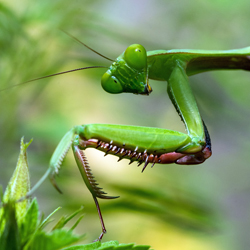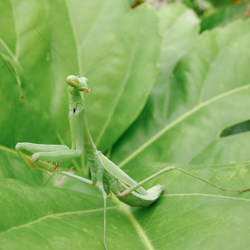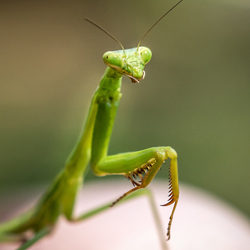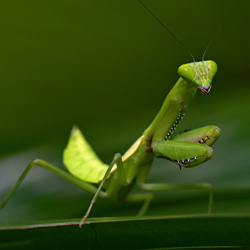This insect can be large and intimidating, but the praying mantis in your garden is a guest to welcome and celebrate, not one to fear or eliminate. Understanding these beneficial insects can help every gardener realize just how useful praying mantids can be.
About the Praying Mantis
There are more than 2,400 species of praying mantis in the world, and they are found in all types of temperate and tropical climates. These large insects range from 2-5 inches in length, and have long, tapered bodies, triangular heads, bulging compound eyes, long jointed forelegs, and semi-upright posture. Their colors range from different shades of green to brown and tan, which serves as excellent camouflage to protect them in their foliage habitats.
Praying mantids have been found as fossils as old as 135 million years, and they’ve evolved to be very efficient insect predators. The average praying mantis lives for just a few months or up to a year, depending on the climate, and females generally lay their eggs in the fall. The egg cases are dormant through the winter, but will hatch in spring so a new generation of praying mantids can be part of the garden.
What a Praying Mantis Eats
These are carnivorous insects that eat a wide range of other insects. Praying mantids are ambush predators, lying in wait and watching carefully for a succulent bite to come within reach of their fast, powerful forelegs. When suitable prey approaches, they will quickly strike, spearing their meal with their sharp, jagged legs.
As generalist predators, praying mantids will eat just about anything they can catch, including aphids, leafhoppers, mosquitos, crickets, grasshoppers, beetles, caterpillars, and flies. Because mantids will hunt at night as well as during they day, they often prey on moths as well. Larger varieties of mantids may also even hunt small lizards, frogs, salamanders, and even hummingbirds.
Gardeners must remember, however, that praying mantids are generalists and do not discriminate about the prey they catch. While they will eat a wide range of insects that can be harmful in the garden, they are just as likely to eat more helpful visitors, including bees, ladybugs, and butterflies. Despite their hearty appetites, however, praying mantids are part of nature’s ecological balance and can be valuable to have in the garden.
Attracting Praying Mantids to Your Garden
A praying mantis can be a very helpful insect in the garden as it eats a wide range of other insects, helping keep different bug populations in check. Attracting mantids is not difficult, but they do require sufficient shrubby foliage for shelter and adequate hunting grounds. Rose and raspberry plants are especially attractive to mantids, and tall grasses are also good praying mantis plants. Foliage should be kept intact rather than severely pruned, and chemical use ought to be minimized, particularly in fall when the females are laying their egg cases, which are more sensitive to pesticides. Organic gardens are the best options and most welcoming landscapes for mantids.
If your garden is not naturally home to praying mantids, you can easily introduce these large insects into your garden’s ecosystem. Egg cases are available for purchase that can yield up to 200-300 young mantids each when they hatch, though of course the mortality of young mantids is quite high. Egg cases can be purchased online or from garden centers and nurseries that offer different beneficial insects. When you receive egg cases, position them in sheltered crooks and crotches of trees and shrubs, ideally in warmer locations with filtered sunlight. The cases will hatch after 10-15 days of warm weather, and the young mantids can disperse throughout the landscape within an hour of hatching.
As you work in your garden throughout the summer, you may occasionally come across a mature praying mantis lying in wait for its next meal. These insects pose no harm to humans, and only rarely bite if stressed and threatened. The best action is to leave the insect as it is, or if it must be moved, gently relocate it to a patch of foliage in a quiet area. Ideally, relocate mantids away from butterfly host plants or active bee colonies to minimize their impact on other beneficial insects.
A praying mantis is a great guest to see in your garden, and their voracious appetites can help provide natural pest control to keep less welcome insects at bay. By understanding these large, carnivorous bugs better, it is easy to provide exactly what they need in your garden and ensure they can fill their own ecological role admirably.




